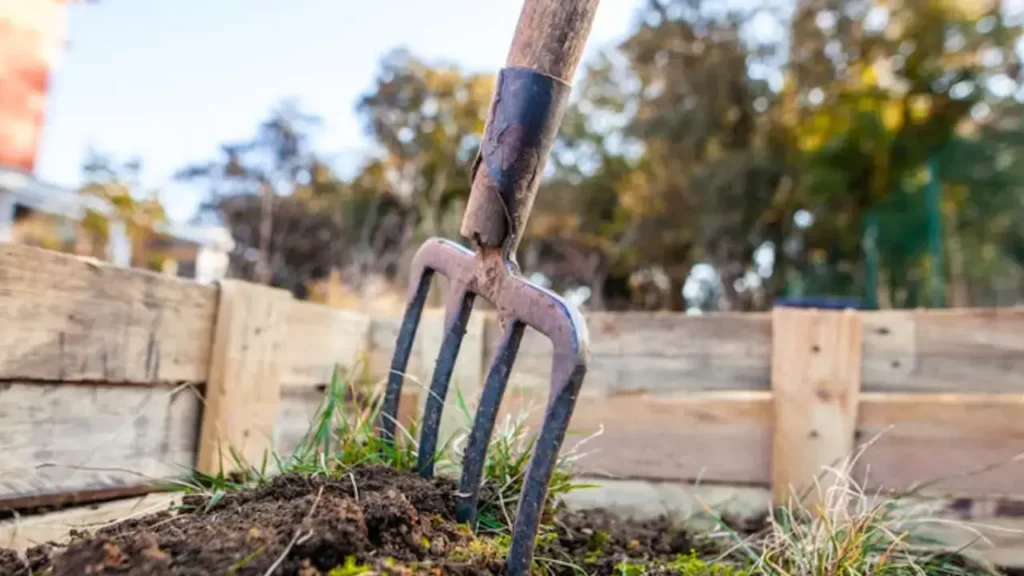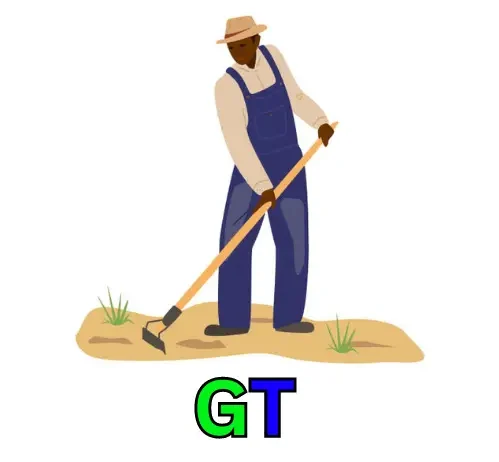Gardening is a beautiful hobby that can give more beautiful results as we put more effort into the process. Now if your beginner or an expert has the right tool will make specific gardening tasks easy and faster. One such helpful gardening tool is a Garden Fork.
So, in this article, we will explore the benefits, uses, and types of garden forks, highlighting why it is an indispensable tool for any gardening enthusiast.

What is a Garden Fork?
A Garden fork is also known as spading fork or digging fork, this is a hand tool with a long handle and several sturdy tines at one end. These tines are designed to penetrate the soil easily and the tines of this fork are commonly made of durable steel. The length and spacing of the tines may vary depending on the type and purpose of the garden fork.
The Benefits of Using a Garden Fork
Here are some of the benefits of the Garden Fork which make many gardening tasks easy.
Loosening Soil
One of the primary use of the garden fork is to loosen the compacted soil, By inserting the tines into the ground and from a rocking motion the Gardner can easily loosen or break up the clumps of soil, which improves the soil texture and allows for better drainage.
This loosening of the soil is an essential process in gardening which will promote the plant’s healthy root growth and prevent waterlogged soil.
Aerating the Ground
Aeration of the soil is an essential maintenance factor for a healthy garden. With the help of a garden fork, the gardener can make holes in the soil which will allow the soil to absorb the water, air, and nutrients that can reach the plant roots easily. Adequate aeration helps prevent soil compaction, improves nutrient absorption, and enhances overall plant growth.
Also Read: Hedge Clippers: the ultimate guide to Trim the Hedges
Digging and Turning Over Soil
When it comes to digging and turning over soil the garden fork is the best tool to use. The strong sturdy tines of the garden fork can easily penetrate the ground making it easy to remove debris, rocks, roots, and any other unwanted stuff. This process will make it easy to plant the seeds and make a fertile environment for young plants.
Removing Weeds and Roots
The garden fork can be used to remove the weed and roots from the garden. By carefully inserting the tines around the weed or unwanted plants you can lift the tines and make the roots loosen of the unwanted plants then you can pull out the plant easily.
The garden fork is a useful tool to remove the larger plants and weeds which cannot easily be removed by a garden hoe.
Different Types of Garden Forks
There are different types of gardening forks with different designs and shapes made to do specific gardening tasks. Here are the three common types of garden forks.
Digging Fork
A digging fork with flat and broad tines is suitable for heavy-duty digging tasks. The digging fork is best for breaking up the compacted soil, removing rocks, and digging trenches for planting larger plants or shrubs.
Border Fork
A Broder fork is a smaller size of the digging fork which is smaller and light in weight compared to the digging fork. Due to its compact size, it is suitable to use in flower beds and raised beds. The narrower tines make it easier to maneuver and work around delicate plants without causing damage.
Pitchfork
The Pitchfork is not really a garden fork but due to its similar function and design it can be considered a garden fork. The pitchfork has longer tines with greater spacing between them. They are commonly used for moving large piles of compost, straw, or hay.
Also Read: Half moon edger vs Spade which is the best garden tool for you
How to Choose the Right Garden Fork
Choosing the right garden fork is crucial to get the perfect garden fork that can provide optimal performance and comfort while doing specific gardening tasks. So consider the following factors while choosing the garden fork for you.
Consider the Material
Primarily look for the quality of the garden fork tines which have to be made of high-quality steel so it can be resistant to bending, and can withstand heavy use without breaking. Also, a fork with rust-resistant coating will last longer and requires less maintenance.
Evaluate the Handle Length and Grip
Check the length of the handle which has to be suitable for your height based on the gardening task you are performing. A longer handle will provide greater leverage which will make it easier for digging and lifting. Also, consider the garden fork with a comfortable grip which should be slip resistant and reduce strain on hands while working.
Check the Tines
Above we mentioned the quality of the tines and quality check for the sharpness and strength of the tines. The sharp tines can easily penetrate the soil and the sturdy tines will withstand pressure and heavy loads. Also, ensure that the tines are securely attached to the handle to prevent any wobbling.
Proper Usage and Maintenance of a Garden Fork
To increase the lifespan of your garden fork with optimal performance follow these guidelines for proper use and maintenance of the garden fork.
Using the Garden Fork Correctly
While using the garden fork position yourself behind the fork, gripping the handle steadily. Insert the tines of the fork into the soil with a slight angle and apply pressure with your foot if needed. Rock the fork back and forth to loosen the soil or lift weeds, ensuring you maintain control over the fork’s movements.
Also Read: How to remove broken garden fork handle and Fix it
Cleaning and Storing the Fork
After every use remove the debris or dirt from the tines and the handle of the garden fork. Rinse it with water and dry it to prevent it from rusting, Then store it in a dry or cold area to prevent moisture, which can damage or rust the tines.
FAQs
What is the difference between a garden fork and a spading fork?
The garden fork and the spading fork are technically the same tools that have similar functions. They both have sturdy
Can a garden fork be used for lifting heavy objects?
The garden fork is primarily designed to work with soil and plant. But it can be used for lifting some weights like rocks, and small tree trumps. But there will be a limit to lifting heavy weights on this, so being overweight can damage the fork.
How often should I sharpen the tines of my garden fork?
There is not any certain period to sharpen the tines of the garden fork but if you use it regularly then whenever you feel that its blades become dull, you can sharpen it.
Is a garden fork suitable for breaking up compacted soil?
Yes, a garden fork will be a good tool for breaking up the compacted soil. The sharp tines of the garden fork can easily penetrate into the soil making holes for aeration and water drainage.
Can a garden fork be used for harvesting root vegetables?
Yes, a garden fork can be used for harvesting root vegetables. Carefully insert the tines of the garden fork around the vegetable plant and gently lift to loosen the plant rots from the soil. This method minimizes damage to the vegetables and makes harvesting easier.
Conclusion
A Garden Fork is an essential tool that every gardener should have and this tool is able to do multiple gardening tasks including digging, weeding, loosening soil, etc. So the gardening fork is a must-have gardening tool for every gardener to maintain a healthy plant.








